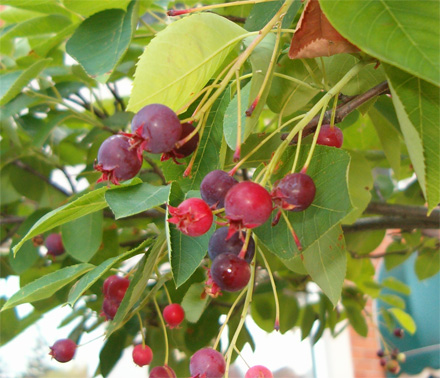Forbidden Fruit
It’s a frequent sight right now in Southern Ontario: trees carrying loads of fruit that look like elongated blackberries. The ground underneath is littered with crushed fruit and stained a deep purple.
When I was a kid I was walking home from school one day with some friends. There was a massive tree of this sort on the route, and a large branch had broken off and fallen to the ground. It was covered in fruit. We didn’t know what it was, but we feasted on it like kings.
I arrived home with face and hands stained purple, and my parents immediately demanded to know what I had been eating. My explanation – “berries off a tree” – alarmed them, and they gave me a stern lecture about how we could have been poisoned.
Even now, when I stop for a moment to grab a bunch, I get odd looks from people who seem to be wondering if I have a death wish as I gobble the fruit no one else seems to want. But mulberries are delicious, and until our culture started mistrusting any food not found in grocery stores, people ate them all the time.
 Big, black and juicy: just the way I like ’em
Big, black and juicy: just the way I like ’em
If people grew big stands of raspberries right next to city sidewalks, I imagine the ripe fruit would not last long as passers-by furtively helped themselves. But mulberry trees by the side of the road – even those whose branches dip low enough for easy harvesting – go untouched.
I can only assume this is because people don’t know what they are, because it’s certainly not due to their taste, which is like a rich, sweet blackberry. You owe it to yourself to try them if you haven’t before!
I wonder just how much free food grows right under our noses. Hamilton has a tree-planting program and I requested a serviceberry for it’s gorgeous spring-time flowers. A friend noticed it and pointed out that its berries are edible. As it turns out, not just edible, but delicious!
 A favourite of robins, serviceberries taste the way they look: like red blueberries
A favourite of robins, serviceberries taste the way they look: like red blueberries
The origins of its name are interesting:
The name serviceberry is derived from the practice of isolated mountain communities in early America to postpone funeral services for those who died in the winter until the spring when the ground was no longer frozen. The flowers of the tree, the first to bloom in the spring, were gathered for church services.
Both of these trees are in season right now, so go eat some berries!
[tags]nutrition, cooking, botany[/tags]


 twitter.com/adriandz
twitter.com/adriandz
